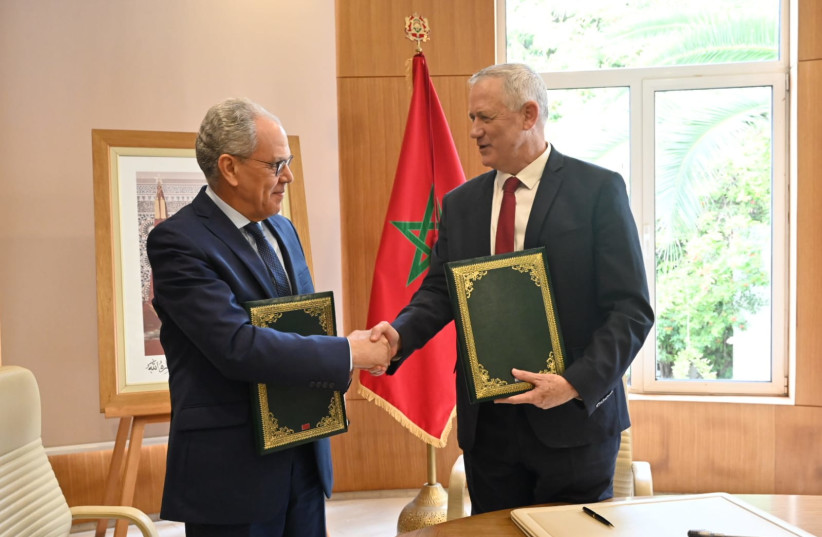It’s getting serious. Arab-Israeli cooperation, for decades an anecdote at best, a tragedy at worst, is suddenly taking wing. The number, substance and scope of recent months’ deals between Israel and its former enemies are dizzying.
In Rabat, Morocco, Defense Minister Benny Gantz and Moroccan Defense Minister Abdellatif Loudiyi signed an agreement that paves the way for Israeli-Moroccan arms deals, intelligence cooperation, and joint military exercises.
Unlike previous Israeli-Arab deals, this one was done in broad daylight, so much so that two Moroccan dailies, the Arabic-language Ahdath Maghribia and the French-language L’Observateur du Maroc, published an article by Gantz, in which he hailed the two nations’ shared history and future.
That happened Wednesday last week. On Monday, Energy Minister Karine Elharrar, Jordanian Water Minister Mohammed Al-Najjar and Emirati Environment Minister Mariam Almheiri signed, in Abu Dhabi, an agreement that will make Israel desalinate water for Jordan, and Jordan deliver Israel solar power, with the UAE delivering Jordan the capital for the deal’s solar-power plant.
Ten days before that, Israeli, Emirati and Bahraini warships maneuvered jointly in the Red Sea, a sight that was dramatic even for the waters that Moses once parted. Then again, that naval fanfare is anecdotal compared with what is happening commercially between Israel and its new peace partners.


In the first six months of formal relations between Israel and the Emirates, its volume soared to $610 million, underscored by the UAE’s launch of a $10 billion fund for strategic investments in Israel, while Israeli products of almost any type began flocking to the UAE.
Israeli farmers have been shipping east freshly harvested dates, Israel Aerospace Industries signed a deal for the joint manufacturing of naval weapons, Clalit Health Fund signed a deal with Emirati insurer Dama for joint research in preventive and digital medicine, and these are but samples of a great commotion, which explains why the dirham is now formally traded in Tel Aviv’s currency markets.
This is of course besides the hectic air traffic which the Abraham Accords uncorked between Dubai and Tel Aviv. A year since the inauguration of direct flights between the two destinations, and the arrivals of 67,000 Israelis in December 2020 alone, El Al said it will fly 14 weekly flights to Dubai, joining eight other airlines already flying this route. The UAE’s Emirates just announced it will fly to Tel Aviv daily.
Is this, then, the New Middle East of which we dreamt back when Yitzhak Rabin and Shimon Peres flew from the Oslo Accords’ signing ceremony to Morocco’s King Hassan II, who soon afterward hosted the first Mideast-North Africa Economic Summit?
THE NEW Middle East vision, as articulated by Peres, foresaw an economically interconnected region in which people, goods, and credit would move as freely as they do within Europe and North America.
Arab leaders, he predicted, would join this trend and set out to create regional highways and railways laced by factories and universities and punctuated by joint airports and electricity grids, some of which would be fed by a regional development bank and all of which would be overseen by a military alliance a-la NATO.
Subsequent events rendered this vision a pie in the sky. War elbowed peace, first between Israel and the Palestinians, then within multiple Arab lands. Before that, Arab leaders effectively rejected Peres’s diagnosis and refused to change the way the Middle East’s economy was run.
Now Peres is vindicated. The governments that are openly building economic enterprises with Israel are following his script, albeit one lost generation after he wrote it.
As this column noted on the Arab upheaval’s 10th anniversary (“The Arab New Deal,” December 20, 2020), the misery that resulted in the past 11 years’ intra-Arab violence, including the Syrian civil war, would have been prevented had the Arab world’s leaders embraced Peres’s New Middle East.
Clearly, Arab leaders’ conclusion from the destitute masses’ toppling of four Arab presidents is that if they won’t give their people more livelihood and dignity, their end might be the same as Muammar Qaddafi’s. The civil wars that followed the protests further multiplied their fear of the people’s wrath.
Now, 11 years after Tunisian grocer Mohamed Bouazizi set himself, and multiple Arab capitals, on fire, the Arab world is split between governments that do and don’t seek economic transformation.
However, Peres’s vision also had a political side, which is now even more elusive than it was in 1993.
INSPIRED BY the downfalls of the Eastern Bloc, the Soviet Union, the communist idea, South America’s dictatorships and South Africa’s apartheid regime, all of which happened shortly before the signing of the Oslo Accords, Peres assumed that the Middle East was ready to democratize.
Better yet, as he implied in his book The New Middle East (1995), Arab leaders would understand the futility of their excessive defense spending and therefore cut it sharply, thus freeing the resources that the New Middle East’s creation required.
The second part of this forecast is materializing, as the biggest Arab defense spenders, Saudi Arabia and Egypt, have indeed reduced their military spending in recent years. Politically, however, Arab regimes’ conclusion from the past decade’s events has been to tighten rather than relax their authoritarianism.
This goes for all the governments which have been intensifying trade with the Jewish state.
Israel, for its part, has long realized that it is in no position to reinvent the Middle East, much the way the US realized it is in no position to reinvent Russia, Afghanistan and Iraq.
And so, what we are now seeing unfold is an economically New Middle East within a politically Old Middle East. Is it the panacea Shimon Peres foresaw? It isn’t. It is, however, so much closer to that than to the bloodshed, bereavement and hatred which his vision was designed to offset.
The writer’s bestselling Mitzad Ha’ivelet Ha’yehudi (The Jewish March of Folly, Yediot Sefarim, 2019), is a revisionist history of the Jewish people’s leadership from antiquity to modernity.
